Class 10 NCERT Solutions- Chapter 6 Triangles – Exercise 6.5 | Set 1
Last Updated :
01 May, 2024
Question 1. Sides of triangles are given below. Determine which of them are right triangles? In the case of a right triangle, write the length of its hypotenuse.
(i) 7 cm, 24 cm, 25 cm
(ii) 3 cm, 8 cm, 6 cm
(iii) 50 cm, 80 cm, 100 cm
(iv) 13 cm, 12 cm, 5 cm
Solution:
(i) Given: 7cm, 24cm, 25cm
(25)2= 25 * 25 = 625
∴They are sides of a right ∆ and hypotenuse = 625
(ii) Given: 3cm, 8cm, 6cm
(8)2 = 8 * 8 = 64
They are not side of right triangle.
(iii) Given: 50cm, 80cm, 100cm
(100)2 = 100 * 100 = 10000
(50)2 + (80)2 = 2500 + 6400
Therefore, this is not right triangle.
(iv) Given: 13cm, 12cm, 5cm
(13)2 = 13 * 13 = 169
(12)2 + (5)2 = 169
Therefore, this is the sides of right triangle and hypotenuse = 169
Question 2. PQR is a triangle right-angled at P and M is a point on QR such that PM ⊥ QR. Show that PM2 = QM × MR.
Solution:
Given: A right ∆PQR right-angled at P and PM⊥QR
To show: PM2 = QM * MR
PM * PM = QM * MR
In ∆PMQ and ∆PMR
∠1 =∠2 -(each 90°)
∠1 +∠2 +∠3 = 180°
90° + ∠4 + ∠5 = 180°
∠4 +∠5 = 180° – 90°
∠3 + ∠4 = 180° – 90°
∠4 +∠5 = ∠3 +∠4
∴∠5 =∠3
∴∆PMQ ~ ∆RMP


MP2 = MQ.PM
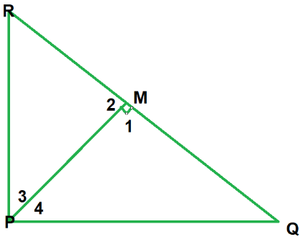
Question 3. In Fig., ABD is a triangle right angled at A and AC ⊥ BD. Show that
(i) AB2 = BC × BD
(ii) AC2 = BC × DC
(iii) AD2 = BD × CD
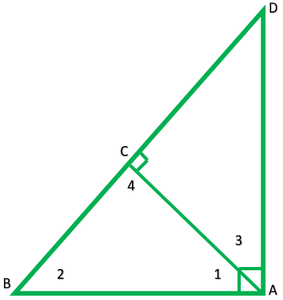
Solution:
Given: A right ∆ABD, right angled at A and AC⊥ BD
To show:
(i)AB2 = BC × BD
(ii) AC2 = BC × DC
(iii) AD2 = BD × CD
(i) AB2 = BC × BD
AB * AB = BC.BD
In ∆ ABC and ∆ABD
∠B =∠B -(common)
∠BCA = ∠A -(each 90°)
∴ ∆ABC~∆DBA

AB2 = BC * DC
(ii) AC2 = BC * DC
AC * AC = BC * DC
In ∆ABC and ∆ACD
∠ACB = ∠ACD -(each 90°)
In ∆ ACB
∠1 + ∠2 + ∠3 = 180°
∠1 + ∠2 + 90° = 180°
∠1 + ∠2 = 90° -(1)
∠1 + ∠3 = 90° -(2)
∠1 + ∠2 =∠1 + ∠3
∴ ∠2 = ∠3
∴ ∆ABC~∆DAC

AC2 = BC * CD
(iii) AD2 = BD × CD
In ∆ABD and ∆ACD
∠A =∠ACD -(each 90)
∠D =∠D -(common)
∴ ∆ABD~∆CAD -(AA similarity)

AD2 = BD * CD
Question 4. ABC is an isosceles triangle right angled at C. Prove that AB2 = 2AC2.
Solution:
Given: ∆ABC right angled at B
To prove: AB2 = 2AC2
According to Pythagoras theorem,
(AB)2 = (AC)2 + (BC)2
(AB)2 = (AC)2 + (AC)2 -(BC = AC)
AB2 = 2AC2
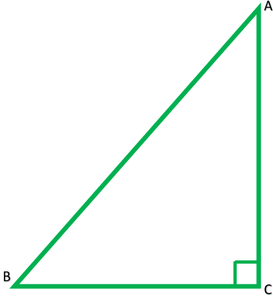
Question 5. ABC is an isosceles triangle with AC = BC. If AB2 = 2AC2, prove that ABC is a right triangle.
Solution:
Given: ∆ABC is an isosceles triangle in which
AC = BC
AB2 = 2AC2
To prove: ABCD is right ∆
AB2 = 2AC2
AB2 = AC2 + AC2
∴ By the, converse of Pythagoras theorem ∆ACB is a right ∆ at C.
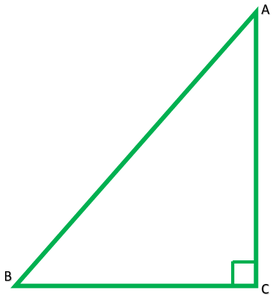
Question 6. ABC is an equilateral triangle of side 2a. Find each of its altitudes.
Solution:
Let ABC is an equilateral triangle of each 2a units
Construction: Draw AD ⊥ BC
In right ∆ ADB
(AB)2 = (AD)2 + (BD)2
(2a)2 = (AD)2 + (a)2
(4a)2 = (AD)2 + a2
4a2 – a2 = (AD)2
3a2 = (AB)2
√3 a2 = AD ∴ Each of its altitude= √3 a unit
√3 a = AD

Question 7. Prove that the sum of the squares of the sides of the rhombus is equal to the sum of the squares of its diagonals.
Solution:
Given: ABCD is a rhombus
To prove: AB2 + BC2 + CD2 + DA2
Proof: ABCD is rhombus and let diagonals AC and BD bisect each other at O.
∴ ∠AOB =∠BOC =∠COD =∠DOA = 90°
In ∆AOB
AB2 = AC2 + BO2
AB2 = (1/2AC2) + (1/2BD2)
AB2 = 1/4(AC2 + BD2)
4AB2 = AC2 + BD2 -(1)
Similarly, in ∆BOC
4BC2 = AC2 + BD2 -(2)
4CD2 = AC2 + BD2 -(3)
4AD2 = AC2 + BD2 -(4)
Adding 1, 2, 3, and 4
4AB2 + 4BC2 + 4CD2 + 4DA2 = 4(AC2 + BD2)
4(AB2 + BC2 + CD2 + DA2) = 4(AC2 + BD2)
∴ AB2 + BC2 + CD2 + DA2 = AC2 + BD2
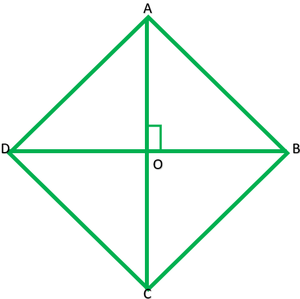
Question 8. In Fig. 6.54, O is a point in the interior of a triangle diagonals.
(i) OA2 + OB2 + OC2 – OD2 – OE2 – OF2 = AF2 + BD2 + CE2
(ii) AF2 + BD2 + CE2 = AE2 + CD2 + BF2
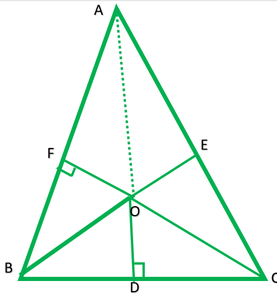
Solution:
(i) In right ∆AFO, by Pythagoras theorem
OA2 = AP2 + OF2 -(1)
In right ∆ODB, by Pythagoras theorem
OB2 = BD2 + OD2 -(2)
In right ∆OEC, by Pythagoras theorem
OC2 = CE2 + OE2 -(3)
Adding 1, 2, and 3
OA2 + OB2 + OC2 = AF2 + BD2 + CF2 + OD2 + OE2
OA2 + OB2 + OC2 – OE2 – OD2 – OE2 = AF2 + BD2 + CE2
(ii) AF2 + BD2 + CE2 = AE2 + CD2 + BF2
OB2 = BD2 + OD2 -(1)
OC2 = DC2 + OD2 -(2)
Subtracting (1) from (2) we get,
OB2 – OC2 = BD2 + OD2 – (DC2 + OD2)
= BD2 + OD2 – DC2 – OD2
= BD2 – DC2 -(3)
Similarly,
OC2 – AD2 = CE2 – EA2 -(4)
AO2 = BO2 = AF2 – FB2 -(5)
Adding 3, 4, and 5, we get,
OB2 – OC2 + OC2 – AO2 + AO2 – BO2 = BD2 – DC2 + CE2 – EA2 + AF2 – FB2
0 + DC2 + EA2 + FB2 = BD2 + CD2 + AF2
Question 9. A ladder 10 m long reaches a window 8 m above the ground. Find the distance of the foot of the ladder from base of the wall.
Solution:
AB is wall = 8m
AC is ladder = 10m
BC = ?
In right ∆ABC, by Pythagoras theorem
(AC)2 = (AB)2 + (BC)2
(10)2 = (8)2 + (BC)2
100 = 64 + (BC)2
100 – 64 = (BC)2
36 = (BC)2
√36 = BC
√(6 * 6) = BC
6 = BC
Hence, the foot of the ladder is at a distance of 6 m from the base of the wall.
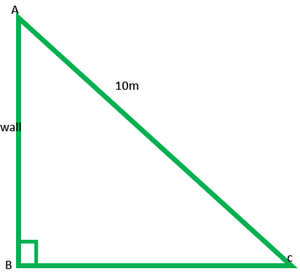
Question 10. A guy wire attached to a vertical pole of height 18 m is 24 m long and has a stake attached to the other end. How far from the base of the pole should the stake be driven so that the wire will be taut?
Solution:
In fig.
AB is pole = 18m
AC is wire = 24m
BC = ?
In right ∆ABC, by Pythagoras theorem
(AC)2 = (AB)2 + (BC)2
(24)2 = (18)2 + (BC)2
576 = 324 + (BC)2
576 – 324 = (BC)2
252 = (BC)2
√252 = BC
√(2 * 2 * 3 * 3 * 7) = BC
2 * 3√7 = BC
6√7 = BC
∴ Hence, the stake may be placed at distance of 6√7 from the base of the pole.
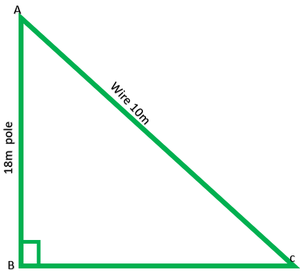
Share your thoughts in the comments
Please Login to comment...